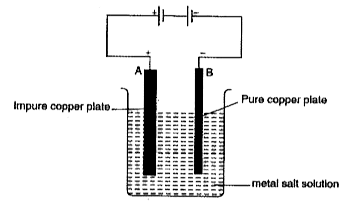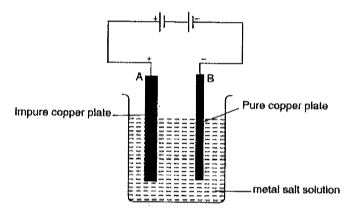Fill in the blank
If you pass current through copper sulphate solution, copper gets deposited on the plate connected to the _____ terminal of the battery.
To solve the question, we need to understand the process that occurs when electric current passes through a copper sulfate solution. Here’s the step-by-step solution:
1. Understanding Electrolysis: When electric current is passed through a solution, a process called electrolysis occurs. In this process, the compound in the solution breaks down into its constituent ions.
2. Identifying the Solution: In this case, the solution is copper sulfate (CuSO4). When copper sulfate is dissolved in water, it dissociates into copper ions (Cu²⁺) and sulfate ions (SO4²⁻).
3. Connecting the Battery: Two electrodes (plates) are immersed in the copper sulfate solution and are connected to a battery. One plate is connected to the positive terminal of the battery, and the other plate is connected to the negative terminal.
4. Movement of Ions: In electrolysis, positive ions move towards the negative terminal (cathode) and negative ions move towards the positive terminal (anode). Therefore, the copper ions (Cu²⁺), being positively charged, will move towards the plate connected to the negative terminal of the battery.
5. Deposition of Copper: As the copper ions reach the plate connected to the negative terminal, they gain electrons and get reduced to form solid copper, which gets deposited on that plate.
6. Conclusion: Thus, the plate that receives the copper deposition is the one connected to the negative terminal of the battery.
Final Answer:
If you pass current through copper sulfate solution, copper gets deposited on the plate connected to the negative terminal of the battery.
---
If you pass current through copper sulfate solution, copper gets deposited on the plate connected to the negative terminal of the battery.
Topper's Solved these Questions
Similar Questions
Fill in the blank
If you pass current through copper sulphate solution, copper gets deposited on the plate connected to the _____ terminal of the battery.View SolutionTbe diagram shows the process of purification of copper metal A thick copper p]ate A of impure copper and a thin copper plate B are immersed in a metal ·sulphate solution and an. electric current is passed through it.

Which electrode is connected to the positive terminal of the battery?View Solution
Knowledge Check
- Question 1 - Select One
Which metal can deposit copper from copper sulphate solution ?
AMercuryBIronCGoldDPlatinum - Question 2 - Select One
Aqueous solution of copper sulphate
Aturns blue litmus redBturns red litmus blueCdoes not affect litmsDaffect both red and blue litmus. - Question 3 - Select One
When 96500 coulomb of electricity is passed through a copper sulphate solution, the amount of copper deposited will be:
A0.25 molB0.50 molC1.00 molD2.00 mol
Tbe diagram shows the process of purification of copper metal A thick copper p]ate A of impure copper and a thin copper plate B are immersed in a metal ·sulphate solution and an. electric current is passed through it.

Which electrode is connected to the negative terminal of the battery?View SolutionWhen 96500 coulomb of electricity is passed through a copper sulphate solution, the amount of copper deposited will be
View SolutionWhich metal can deposit copper from copper sulphate solution ?
View SolutionAn electric current is passed through silver nitrate
solution using silver electrodes and 10.79 g of silver was
found to be deposited on the cathode. If the same amount
of electricity is passed through copper sulphate solution
using copper electrodes, the weight of copper deposited
on the cathode isView SolutionAn electric current is passed through silver nitrated solution using silver electrodes . 10.79g of silver qas found to be deposited on the cathode fi the same amount of electricity is passed through copper sulphate solutin using copper electrodes. the weihgt of copper deposited on teh cathode is .
View Solution

